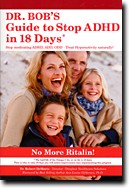|
|
Dr. Bob's Guide to Stop ADHD in 18 Days
Book Review by Jonice Owen, DC, FACO, CHom
|
Title:
|
Dr. Bob's Guide to Stop ADHD in 18 Days
|
|
Author:
|
Robert DeMaria, DC, DABCO
|
|
Publisher:
|
Drugless Healthcare Solutions, 2005
|
|
Part #:
|
T-279
|
 Dr. Bob's Guide to Stop ADHD in 18 Days is a self-published text that offers a variety of suggestions to parents of children diagnosed with ADHD, specifically parents searching for alternative solutions. This book doesn't profess to be a cure-all or an end-all, and it's not. This is an excellent "reception area" text or take-home informational book for your patients. It is chock-a-bloc full of informational bytes that will aid the doctor in giving verbal information to patients. Much of the information is short and sweet.
For the patient, Dr. Bob uses a "personal" voice and offers his story; he also draws from popular periodicals such as USA Today and The Wall Street Journal. The reader is treated to lots of user-friendly information about the body, how cells work, how the digestive system works, and how hormones tie into mental functioning.
Dr. Bob tells us: "Lack of knowledge on how the body works is a leading factor in behavioral disorders. Educated patients (parents) make wise choices." One example is his lay-oriented explanation of the role of omega 3 in prostaglandin production: Dr. Bob's Guide to Stop ADHD in 18 Days is a self-published text that offers a variety of suggestions to parents of children diagnosed with ADHD, specifically parents searching for alternative solutions. This book doesn't profess to be a cure-all or an end-all, and it's not. This is an excellent "reception area" text or take-home informational book for your patients. It is chock-a-bloc full of informational bytes that will aid the doctor in giving verbal information to patients. Much of the information is short and sweet.
For the patient, Dr. Bob uses a "personal" voice and offers his story; he also draws from popular periodicals such as USA Today and The Wall Street Journal. The reader is treated to lots of user-friendly information about the body, how cells work, how the digestive system works, and how hormones tie into mental functioning.
Dr. Bob tells us: "Lack of knowledge on how the body works is a leading factor in behavioral disorders. Educated patients (parents) make wise choices." One example is his lay-oriented explanation of the role of omega 3 in prostaglandin production:
"Prostaglandins are important for the regulation of inflammation, pain, swelling, blood pressure, heart function, gastrointestinal function and secretions, kidney function and fluid balance, blood clotting and platelet aggregation (stickiness), allergic response, nerve transmission, and steroid production and hormone synthesis. As you can see, prostaglandins and EFAs are vital to proper body and neurological functioning!"
The text is peppered with bolded sections that highlight tidbits of repeatable information. A few examples: "The average American consumes 149 pounds of refined sugar each year. If your body were to convert this, it would add 79 pounds of fat." "White sugar is a human invention, not a gift from nature. In 1975, Louisiana farmers devised a cheaper way to granulate sugar on a large scale, which made white sugar available to the masses."
As doctors, we constantly inform our patients regarding proper nutrition and its role in our health. This text hits home, as chapter nine makes clear: "Hitting the Hype: You Are What You Eat." An example is improper fat metabolism, which Dr. Bob addresses, as well as the effects of ingesting common foods such as cow's milk, processed sugars, fast foods, and prepackaged, canned, cellophane-wrapped food.
The book is food for thought and reminds us of the multitude of potential contributors to "hyperactivity," such as the mother's health during the birthing process, birth order of siblings, familial situations, and having good communication with your child's teacher.
In chapter 10, I found the section, "Good, Better, Best, Never Let It Rest Until Good Becomes Better and Better Becomes Rest," to be very helpful. This section contains an excellent chart for making a smooth transition to healthier foods. Additionally, "Prizewinning Pilot Program" (chapter 18) supplies useful and manageable tips for lifestyle patterns.
No book touting ingestion of good food is complete until you get to the recipes section Chapter 19, "Hype-Free Irresistible Recipes" contains sections on "Mighty Meals," "Dressings" and also "Sweet Suggestions."
It is always delightful to offer well-written books to our patients, particularly those written by chiropractors. The chapter on treatment of nerve interference and subluxation supports the comprehensive approach to treatment of this health concern, and serves as stand-alone information for chiropractic patients. For those who choose to read on, the up-to-date, patient-focused material offers resources for the reader to locate products, food sources (Web site addresses) and information for further research of suggested materials.
Dr. Bob's Guide to Stop ADHD in 18 Days easily rates a 9 out of 10; it is patient-oriented, informational reading material that readily supports your chiropractic treatment of ADHD. This readable book works as a tool and will benefit your patients in filling in any gaps in their understanding of the many natural alternatives available for the treatment of ADHD.
Dr. Owen's Rating:
 9
out of
10
9
out of
10
|

|








